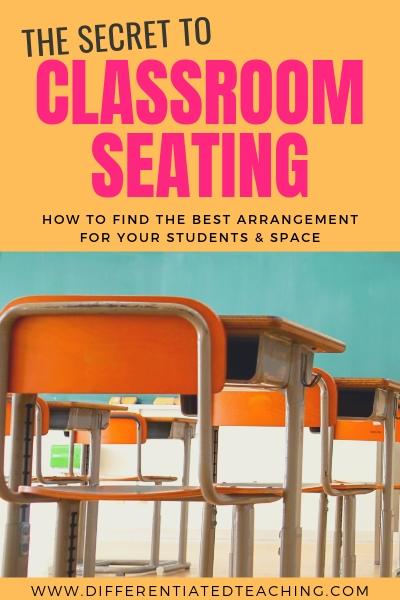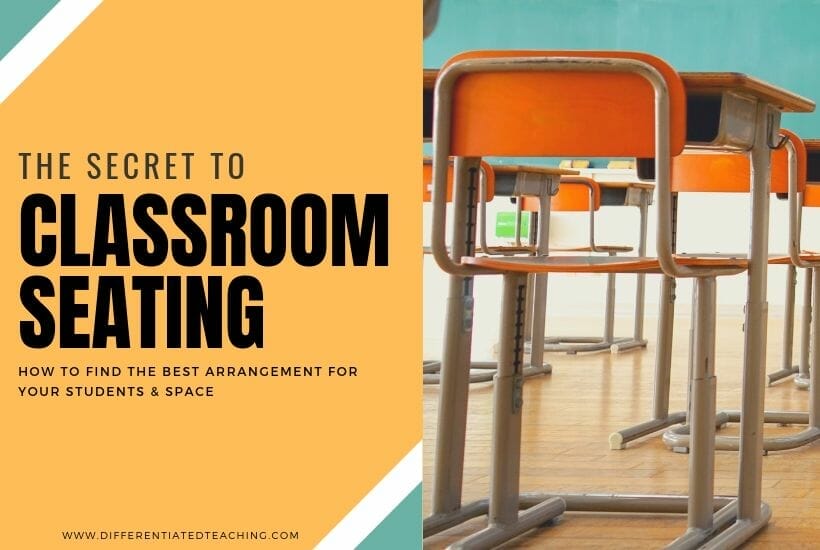
Deciding on a seating chart in your classroom can be a challenge. Who should sit together? Who MUST sit apart? However, before you can begin assigning seats in class, you must make the challenging decision about how to arrange the desks or tables. While it seems simple, there are so many different classroom seating arrangements to choose from and each has its own pros and cons. You’ve also got to take into account any flexible seating options you might have. So how do you decide the best seating arrangement for your classroom?
The reality is there is no single correct answer to the age-old question of how to best arrange your desks. Even when you try to find the research, it is difficult to find empirical evidence to support putting desks in rows, pairs, or table teams. So what’s a teacher to do?

You probably aren’t surprised to read that the seating arrangement has an impact on student learning. Studies have shown that students who are in the front rows are typically more attentive than those in the back. They are more likely to ask questions and actively participate.
However, few elementary classrooms offer open seating, where students self-select their desk. Instead, we select students that need close proximity to maintain attention or get adequate support to sit in the front rows. Our goal is to improve those students’ time on task and learning through our consistent interaction.
While you probably already knew that front row seats encourage engagement, did you know that your seating arrangement has also been shown to impact how you communicate with your class and how they communicate with peers? This makes it critical that we create seating arrangements that align with our instructional goals and activities so we can maximize student learning.
As you begin to consider your seating chart for this year, check out the pros and cons of several popular classroom seating arrangements. Hopefully, this will help you decide what is right for you, your students, and your classroom.
This arrangement likely needs little explanation. It was designed for a lecture, where students sit facing the instructor with their backs to one another.
Students in the front rows have the highest rates of engagement while back rows tend to be less engaged.
This style of seating can also be done on an angle, often called stadium seating. In this layout, the desks are in angled rows and may or may not touch.
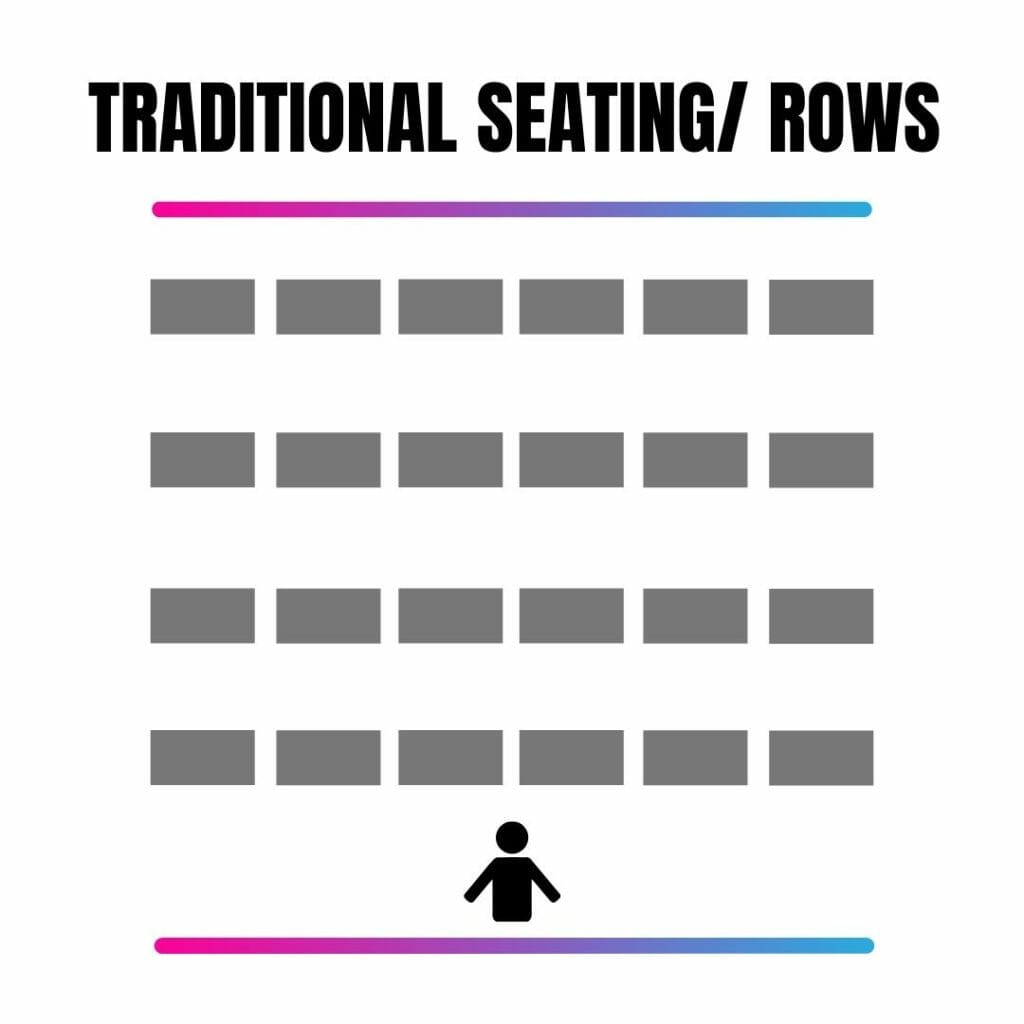
Rows work well if you have lots of space and there is little expectation for group or partner work at desks.
This set up also encourages less talking during instruction. With all students facing you, they are easily able to see the board.
Most classrooms are not spacious, meaning that you’ll most likely need to do a modified version of this (like stadium seating) or choose a different seating arrangement.
Rows are not conducive to cooperative learning or group work, and they can be challenging when it comes to classroom management unless you have a small class. Once you have three or more rows, it can be challenging to see and keep all students on task.
These cons were a reason my classroom was very seldom in traditional rows outside of state testing. Occasionally, we would do modified rows or stadium seating if the group was having difficulties staying on task and listening. However, cooperative learning and discussion is a huge part of my teaching so the cons of this format majorly outweighed any benefits for me.
The pair arrangement can be done with desks or tables, and allows the teacher to move around the room between pairs.
Two students can sit at a single trapezoid table, if your classroom has tables instead of desks.
Alternatively, two desks can be pushed together to create a pair.
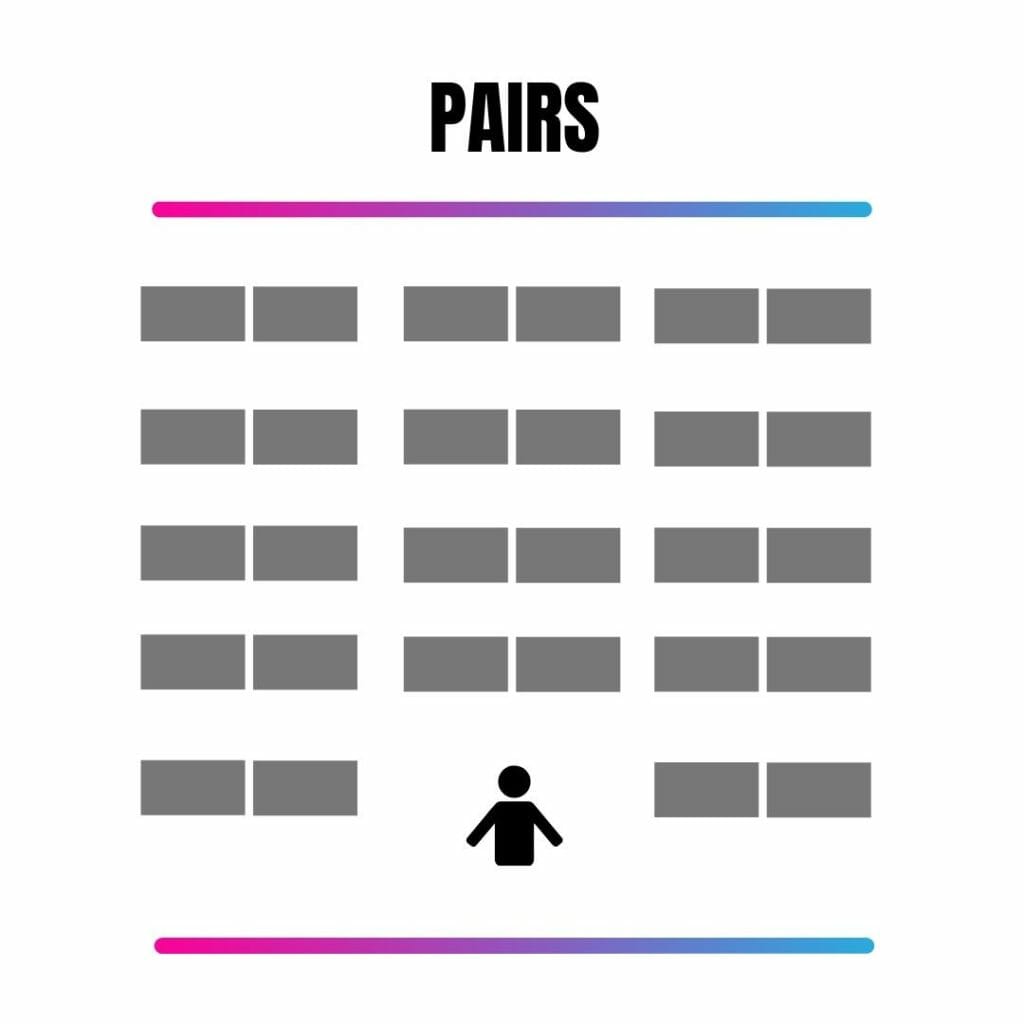
This is a great classroom seating arrangement for controlled conversations and partner work. Since you’ve selected the pairs, you can purposefully partner students who may work well together.
I loved using this arrangement later in the year, once I got to know my students and their personalities a little better because it allowed me to purposefully partner students in a way that allowed both partners to shine and lift one another up, academically. The partnerships often led to very rich discussions, which could then be shared in the larger class discussion.
This arrangement typically uses slightly less floor space than traditional rows, and it creates an environment where partnership and cooperative learning is expected.
Sitting in pairs also has some downsides. Since students are in partners, it can be more difficult to stop talking or off-task behavior. You may find that 1-2 students need to be “islands” and sit separated from a partner to do their best learning and maintain focus. Depending on how you present this, it can be stigmatizing for a student to have to sit alone.
I found that it was really important to explain why the student was becoming an island when I made this move. I also made sure to explain what he or she needed to do to become part of a pair again.
Depending on the parent, I also communicated this adjustment to parents to let them know why their child had been placed away from peers, making sure to discuss the benefits for their child and his or her learning rather than the idea of this being a punishment.
The arrangement also tends to still take up quite a bit of classroom space, so it can be difficult to pull off with large classes or in small rooms. You may also need to make a trio if you have an odd number of students.
This is a modification of a round-table format, where students and teachers share one large table area (or desk area) for discussion.
The traditional round-table arrangement is uncommon in classrooms due to the number of students and space needed to accommodate the arrangement. Therefore, it is not included in the layouts discussed.
For the semi-circle or u-shape arrangement, participants face each other, but the teacher has space to move around the room.
This arrangement has also been referred to as a horseshoe, and there is a modified version called the double horseshoe that involves an inner and outer semi-circle.
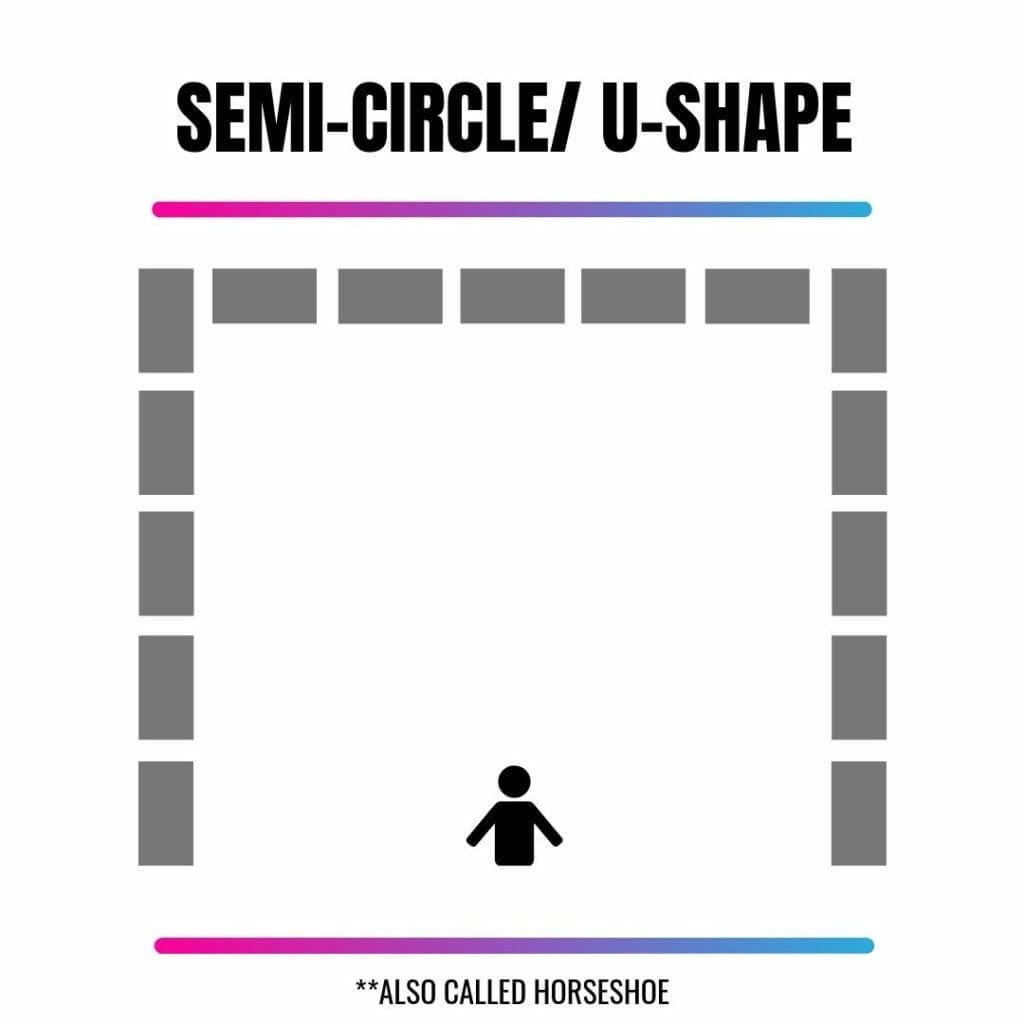
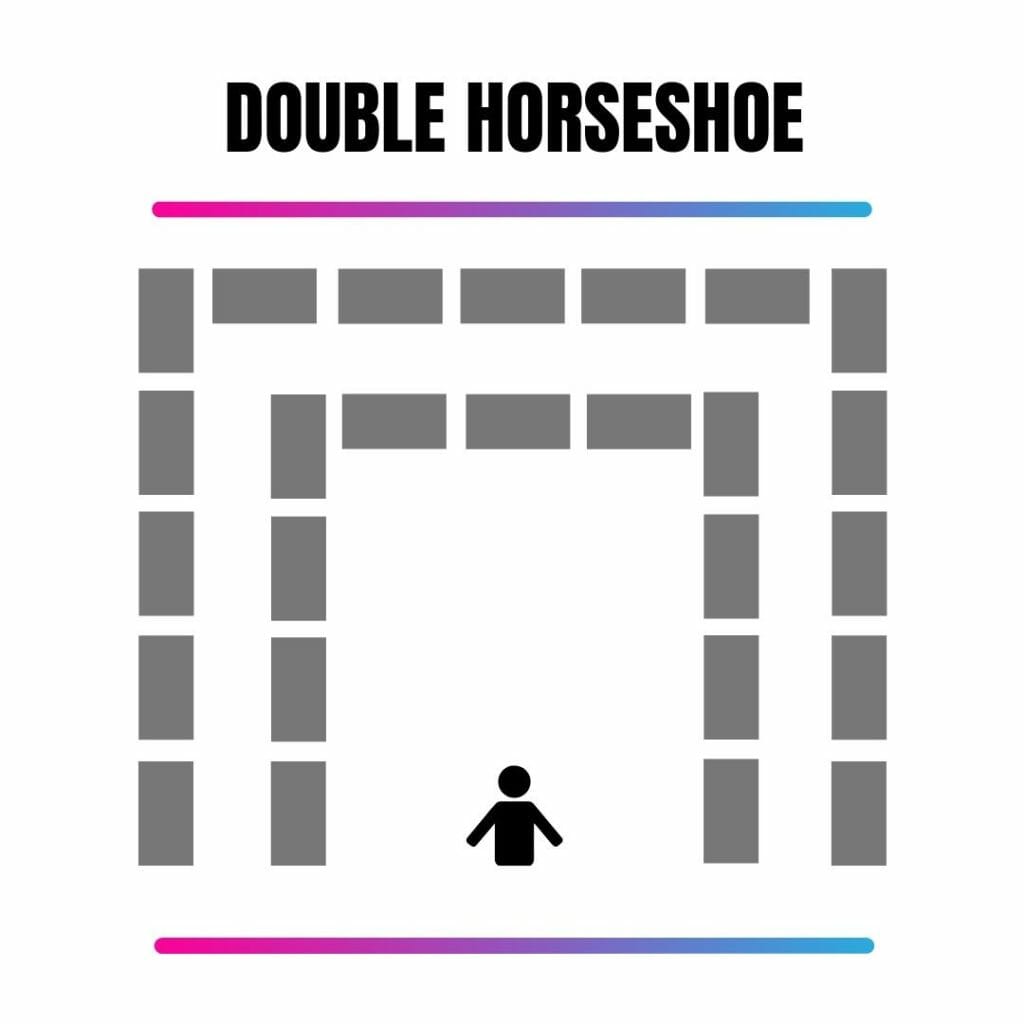
This layout is great for classrooms that want to encourage discussion between the students and teacher. Students can still see anything projected onto the board, which makes it great for classroom conversations.
The double horseshoe layout, which has the inner and outer semi-circles, offers a slightly more restricted format for conversation. This can be a good alternative if you need some additional control of student interaction or in cases where you have a large number of desks in a small space.
I loved the double horseshoe those years that I had a rambunxious group where several students were able to set off peers because I could still make sure the students were seated in a way that reduced their likelihood of interactions. I could also have the kiddos who needed extra support closer to the front without the distractions from the entire class.
There are several major cons to this arrangement, but there are also a few fixes that I will share. This was an arrangement I used in my room regularly, but I had to find some adjustments.
The U-shape format requires lots of room, which means most classrooms will need to use a double horseshoe layout to make this work. One negative of the double horseshoe is that students often turn around and get chatty with peers behind them.
One of the biggest cons of this arrangement, however, is that kids move! When they move their desks tend to move with them.
Since my students sat on yoga balls, this was likely a bigger issue in my class than I would’ve seen with traditional desks and chairs, but we were constantly having to push desks back into their U-shaped format. I occasionally debated about using zip-ties to keep the desks together, but never actually went that far.
Another con was the fact that it was harder to get to the students in the outer U when I did the double horseshoe format. I solved this by leaving a space in the center of each so I could quickly and easily access all of my students if they needed help or had questions during work times. Here’s what the layout looked like with that modification:
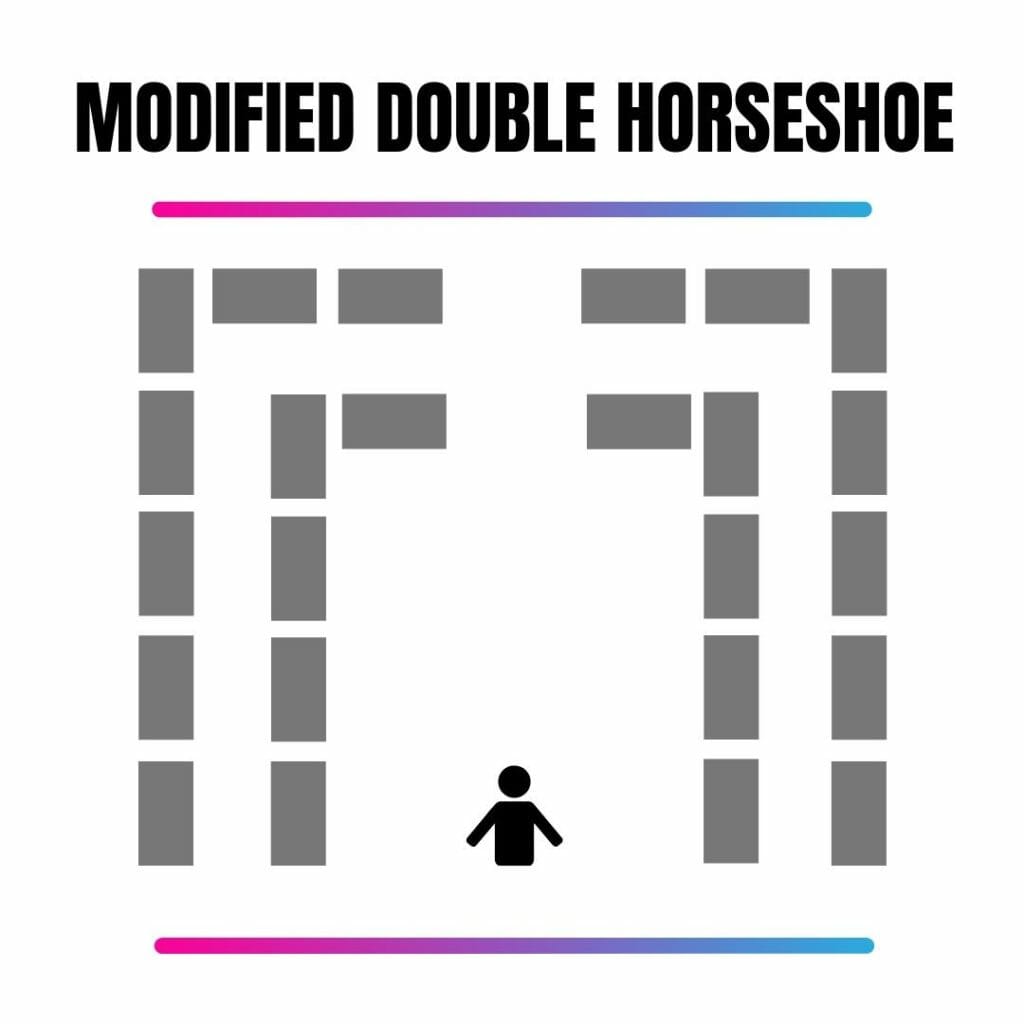
Finally, table groups are a common arrangement in many classrooms. Depending on how many students you have and whether you use desks or have tables in your room, you can create groups of 4-5 students.
Since this is one of the most common classroom layouts, I won’t spend too much time digging into what it looks like. Instead, let’s talk about the pros and cons of this classroom seating arrangement.
This type of classroom seating arrangement is amazing for group work and cooperative learning.
This was typically how I started my school year because I wanted to encourage students to get to know one another.
This arrangement is great for large classes or small classrooms because it saves space.
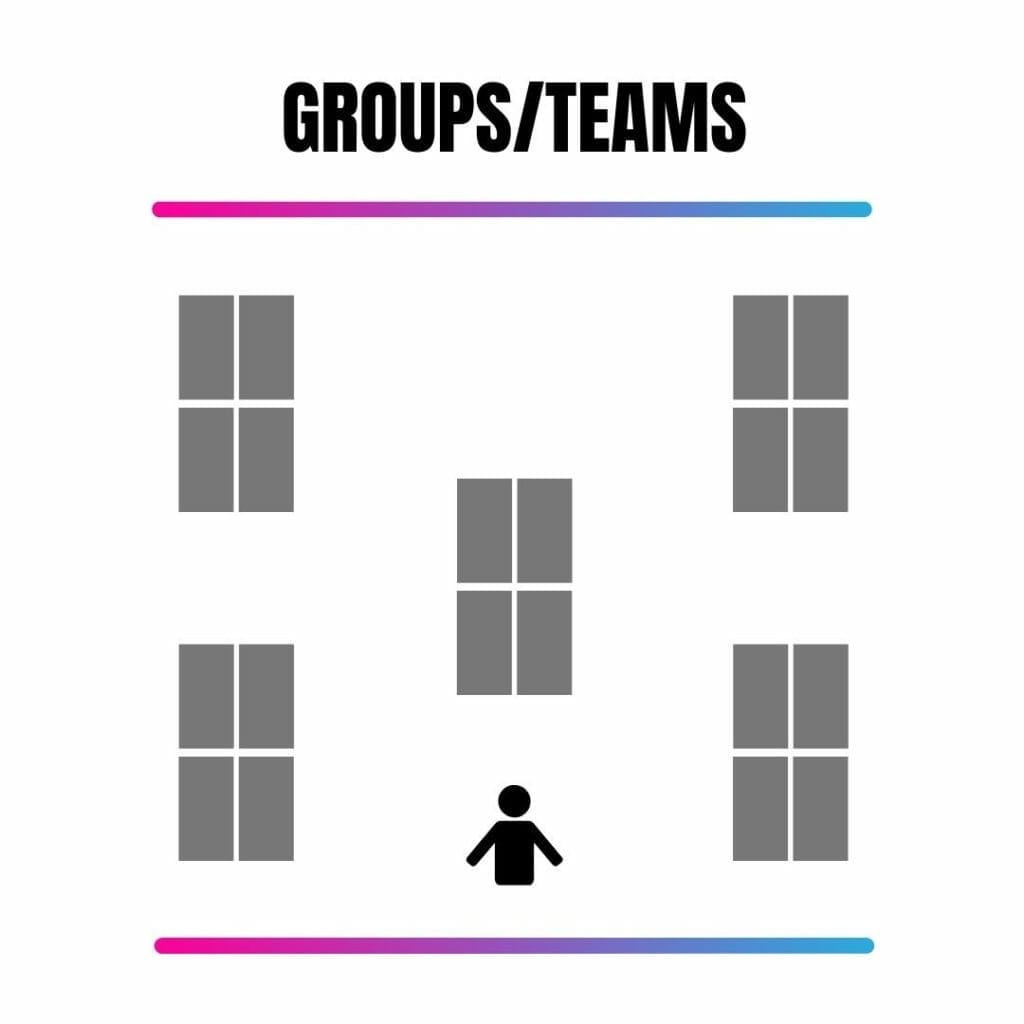
By purposefully planning your groups, you can build upon student strengths and use the format as a part of your behavior management plan. Table points were a great way to build some friendly competition in my classroom, and they were great for encouraging on-task behavior.
Remember how I mentioned that I liked to start the year in table groups? Well, we never stayed there for long. Here’s why –
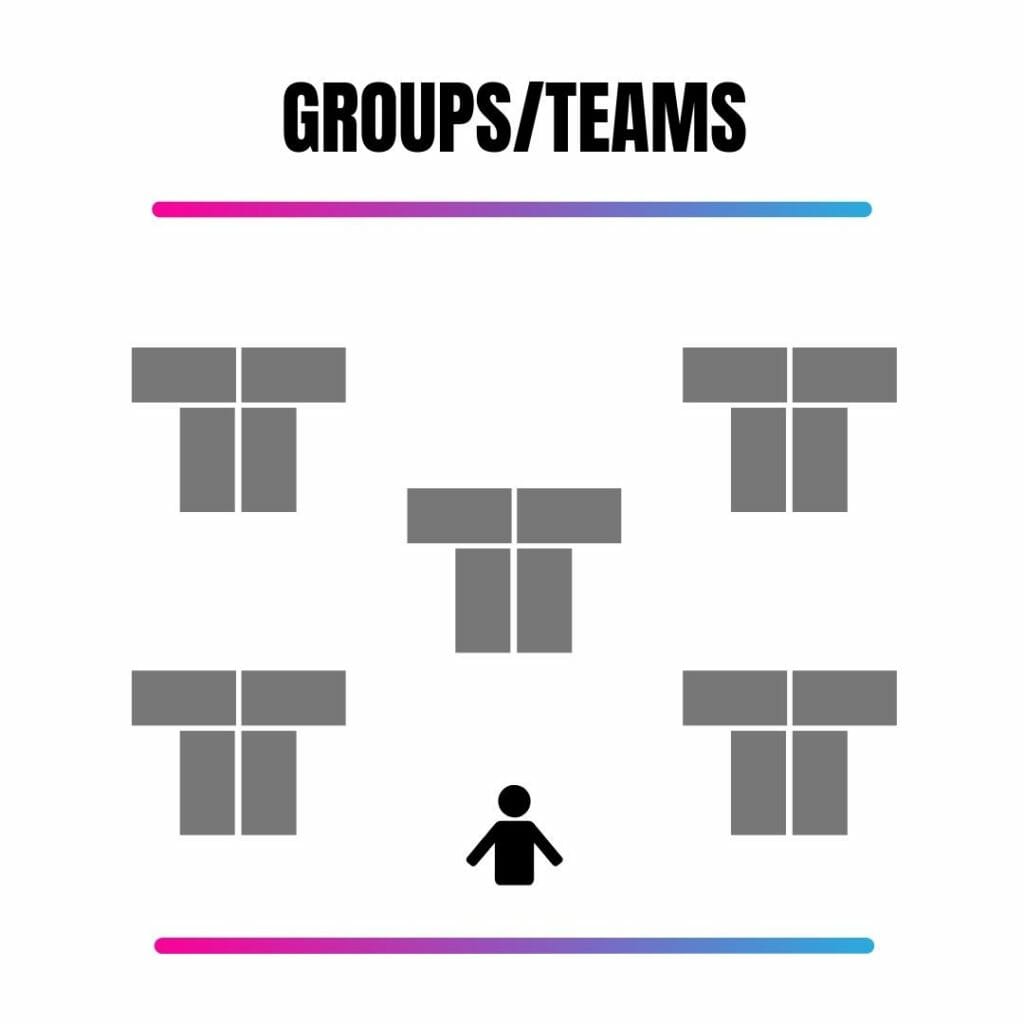
This classroom seating arrangement is great for cooperative learning, but it is TERRIBLE for keeping talking to a minimum.
After the first few weeks, I typically had to move my students out of this arrangement because it was becoming a barrier to their learning.
Facing peers promotes off-task behavior for many students, and with groups, it can be challenging to separate behavior issues or chatty friends from one another. There are just too few places to keep them apart.
This is why I typically moved my students’ desks into a double horseshoe layout for the middle chunk of the year. As they matured we were able to transition back into groups or table teams (like below) to finish up the year.
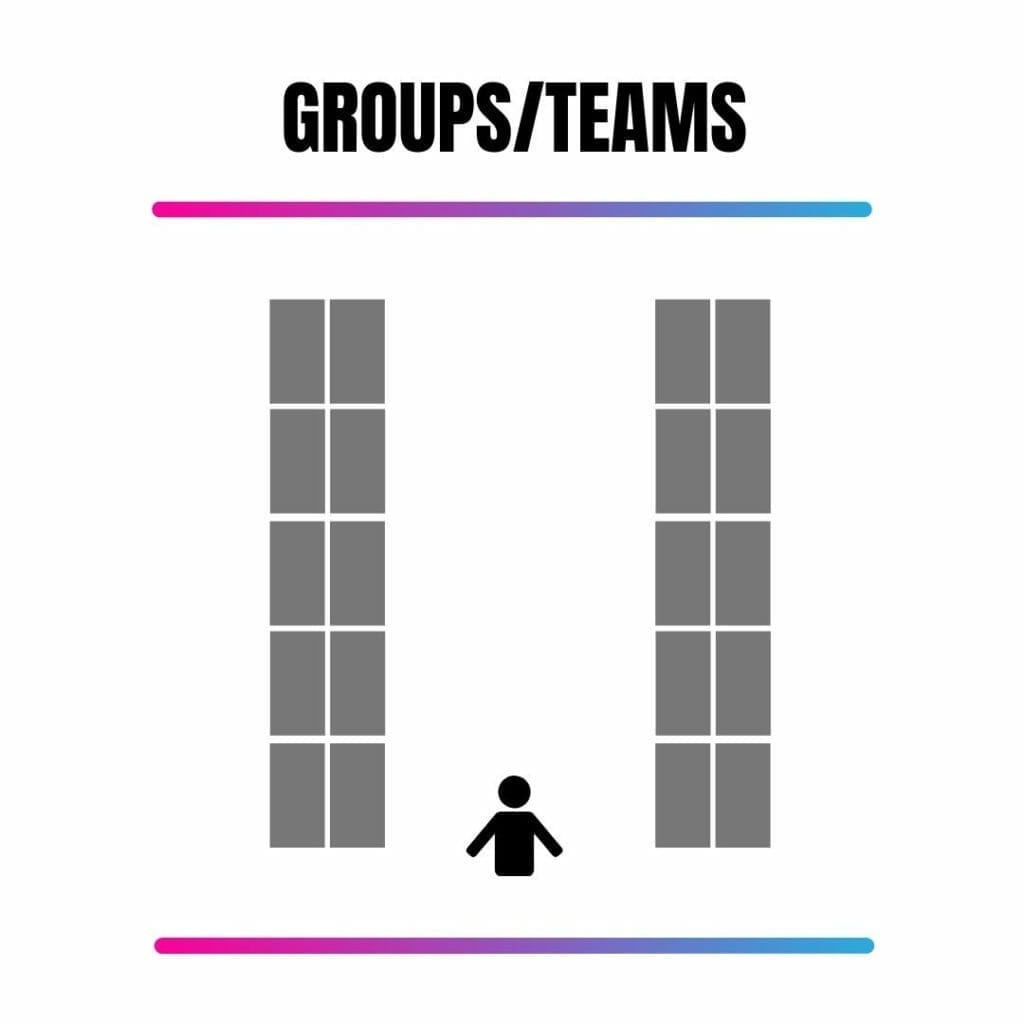
The table teams were the closest I could come to a round-table format, and they really encouraged some interesting discussion. However, they were definitely much harder to manage.
As you can see, there is no one-size-fits-all solution to a classroom seating arrangement. You’ve got to take into account a number of factors to find what is best for you.
There are so many variables to consider, and you don’t need to feel like a failure of groups don’t work for you. (This was a feeling I often struggled with when I reached the point that I needed to move my desks from the table groups they began the year in.)
Instead, consider your classroom layout as a piece of your classroom management system. You use different classroom seating arrangements to serve different purposes and to keep your classroom on-task and learning.
If you are like me, you see grouping as the ideal seating arrangement and feel like you’ve somehow failed when you’re not able to keep your students in groups and still keep everyone on task. I’m giving you permission to let yourself off the hook. Being a great teacher does NOT mean a one size fits all seating plan. Every year is different, and it’s okay for the seating plan to change as well.
That being said, here are some ways you can improve your classroom seating arrangement.
When you plan your classroom seating arrangement, consider the goals of your instruction and the activities you commonly use.
If you’re working through a unit that will have lots of whole group discussion, you may want to use a horseshoe or double horseshoe arrangement.
Working on some cooperative projects, table groups might be perfect!
There is no hard-and-fast rule about how often you should re-arrange your seating assignments, so you can make these adjustments as needed throughout the year. If your class is really on top of it, you can even practice transitioning between 2 different seating arrangements so your students can make a quick change to better meet the needs of the learning experience.
No matter how badly you might want to do a certain arrangement, if it impedes the flow of your classroom, it just isn’t going to work.
Make sure that you’ve got adequate space for any arrangement you decide to try. This means that desks aren’t too close to your small group space or classroom library.
It also means making sure you’re easily able to reach all students to address questions or needs.
Consider a combination configuration if your classroom or students need it. By mixing and matching the arrangements described above you can find a way to meet the needs of all students.
There is no rule that says you can’t create your own layout, so don’t be afraid to play with your seating arrangement until you find a format that works for you. For example, the layout below is great if you have some students who are able to focus in groups, but others that need to fewer distractions or can only handle being partnered during instruction.
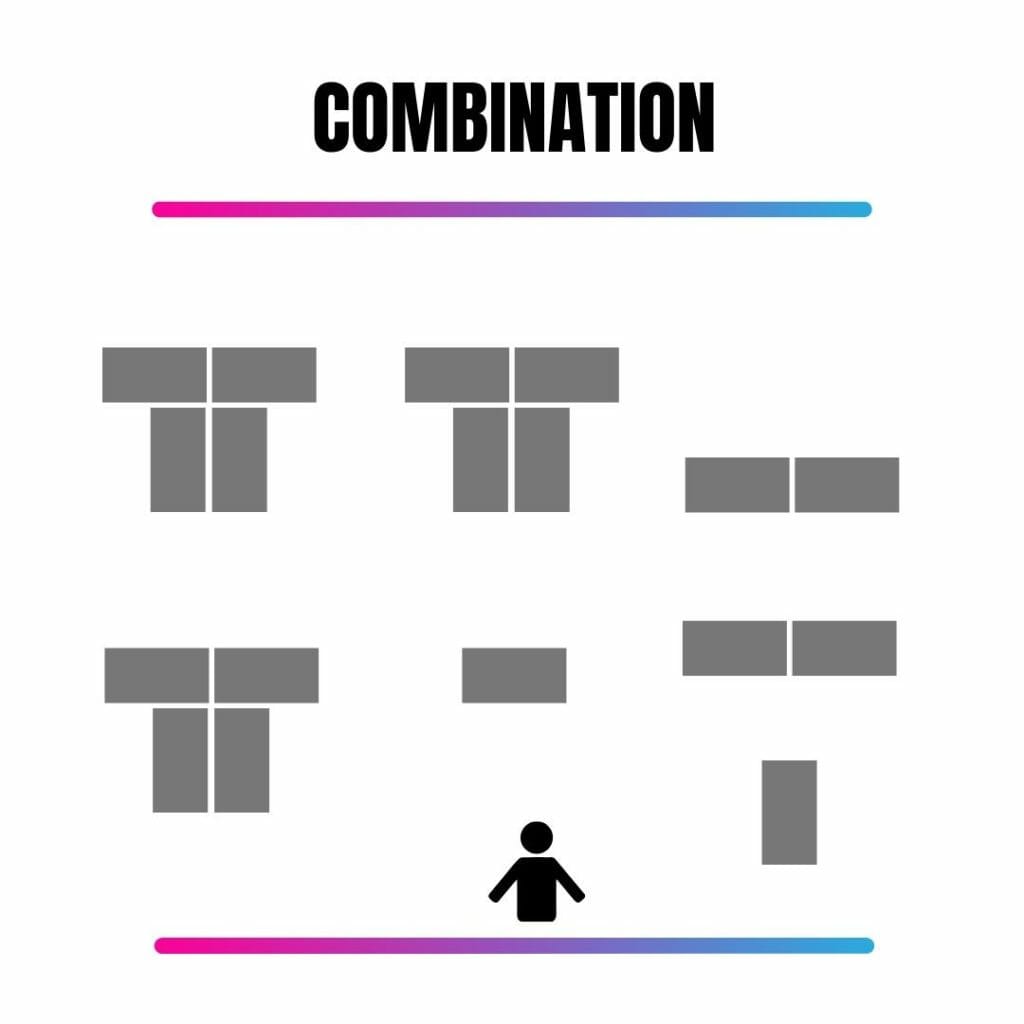
Your seating arrangement may seem like a small thing, but it is an important part of creating an effective classroom. Deciding on a good seating arrangement isn’t easy, and you might discover the great ideas you thought you had are a total mess. There are also so many factors that come into play with your decision.
For example, I once worked with a principal that dictated classroom set-up, right down to the seating arrangement.
While I strongly believe that your seating arrangement should be determined by the individual teacher based on personality, teaching style, and the needs of the current class, there was only so much I could do in that situation so we spent a lot of time out of our desks.
Seating arrangements can certainly be changed throughout the year as students become more independent, more comfortable with each other, or as the needs in your room change.
Some years my team had a running joke that if you wanted to find me, listen for the movement of desks because I strongly believe we should all play around with seating arrangements until we find the one that works best for our class.
This might look different every few weeks as student friendships and maturity grow and change or we move into different units with new activities and goals. That’s okay!
I’ve rarely had students care about the fact that the seating arrangement is changing because I do my best to be upfront about the reasons for the change. Sometimes it is to increase focus or separate chatty friends. Other times I make moves to help students work with someone new.
Quite honestly, my more introverted students are relieved when they can have their own space to work in peace and quiet so many of my moves work out better for everyone in the end.
Don’t be afraid to get creative when it comes to classroom seating arrangements.
